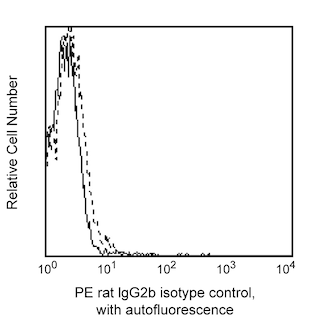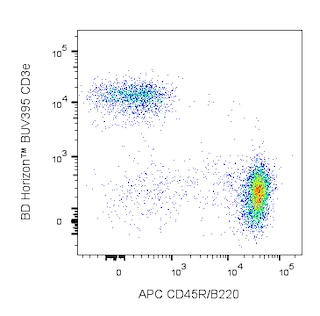Old Browser
This page has been recently translated and is available in French now.
Looks like you're visiting us from {countryName}.
Would you like to stay on the current country site or be switched to your country?


.png)

Two-color flow cytometric analysis of CD117 (c-kit) expression on mouse bone marrow cells. C57BL/6 mouse bone marrow cells were preincubated with Purified Rat Anti-Mouse CD16/CD32 antibody (Mouse BD Fc Block™) (Cat. No. 553141/553142). The cells were then stained with APC Rat Anti-Mouse CD45R (Cat. No. 553092/561880) and with either PE Rat IgG2b, κ Isotype Control (Cat. No. 555848; Left Plot) or PE Rat Anti-Mouse CD117 (c-kit) antibody (Cat. No. 567471; Right Plot) at 0.06 μg/test. A pseudocolor density plot showing the correlated expression of CD117 (c-Kit) [or Ig Isotype control staining)] versus CD45R/B220 was derived from gated events with the forward and side light-scatter characteristics of viable cells. Flow cytometry and data analysis were performed using a BD LSRFortessa™ Cell Analyzer System equipped with a Blue Laser and FlowJo™ software. Data shown in this Technical Data Sheet are not lot specific.
.png)

BD Pharmingen™ PE Rat Anti-Mouse CD117 (c-kit)
.png)
Regulatory Status Legend
Any use of products other than the permitted use without the express written authorization of Becton, Dickinson and Company is strictly prohibited.
Preparation And Storage
Recommended Assay Procedures
BD™ CompBeads can be used as surrogates to assess fluorescence spillover (Compensation). When fluorochrome conjugated antibodies are bound to BD™ CompBeads, they have spectral properties very similar to cells. However, for some fluorochromes there can be small differences in spectral emissions compared to cells, resulting in spillover values that differ when compared to biological controls. It is strongly recommended that when using a reagent for the first time, users compare the spillover on cells and BD CompBeads to ensure that BD™ CompBeads are appropriate for your specific cellular application.
Product Notices
- Please refer to www.bdbiosciences.com/us/s/resources for technical protocols.
- Caution: Sodium azide yields highly toxic hydrazoic acid under acidic conditions. Dilute azide compounds in running water before discarding to avoid accumulation of potentially explosive deposits in plumbing.
- Since applications vary, each investigator should titrate the reagent to obtain optimal results.
- For fluorochrome spectra and suitable instrument settings, please refer to our Multicolor Flow Cytometry web page at www.bdbiosciences.com/colors.
- An isotype control should be used at the same concentration as the antibody of interest.
- Please refer to http://regdocs.bd.com to access safety data sheets (SDS).
Companion Products






The ACK2 monoclonal antibody specifically binds to CD117, which is also known as Proto-oncogene c-Kit (c-kit), Stem Cell Factor Receptor (SCFR), and Mast/stem cell growth factor receptor. This ~145 kDa type I transmembrane glycoprotein is encoded by Kit (KIT proto-oncogene receptor tyrosine kinase) which belongs to the receptor tyrosine kinase family (RTK) within the immunoglobulin superfamily (IgSF). CD117 (c-kit) serves as a receptor for c-Kit ligand (aka, stem cell factor or SCF). This receptor is expressed on multipotent hematopoietic stem cells and progenitors committed to myeloid and/or erythroid lineages, and precursors of B and T lymphocytes. CD117 (c-kit)-mediated signaling plays an important role in the activation, growth, proliferation, differentiation, and survival of cells in sustaining hematopoiesis. It is also involved in the development of mast cells and melanocytes. The specificity and functional activity of the ACK2 antibody is like that of another CD117 (c-kit)-specific antibody, ACK45. ACK2 is reported to block CD117 (c-kit) signaling in vitro and in vivo.

Development References (6)
-
Czechowicz A, Kraft D, Weissman IL, Bhattacharya D. Efficient transplantation via antibody-based clearance of hematopoietic stem cell niches.. Science. 2007; 318(5854):1296-9. (Clone-specific: Flow cytometry, Functional assay, Inhibition, In vivo exacerbation). View Reference
-
Géraud C, Koch PS, Zierow J, et al. GATA4-dependent organ-specific endothelial differentiation controls liver development and embryonic hematopoiesis.. J Clin Invest. 2017; 127(3):1099-1114. (Clone-specific: Flow cytometry, Fluorescence activated cell sorting). View Reference
-
Hozumi K, Kobori A, Sato T, et al. Pro-T cells in fetal thymus express c-kit and RAG-2 but do not rearrange the gene encoding the T cell receptor beta chain.. Eur J Immunol. 1994; 24(6):1339-44. (Clone-specific: Functional assay, Inhibition). View Reference
-
Nishikawa S, Kusakabe M, Yoshinaga K, et al. In utero manipulation of coat color formation by a monoclonal anti-c-kit antibody: two distinct waves of c-kit-dependency during melanocyte development. EMBO J. 1991; 10(8):2111-2118. (Immunogen: Functional assay, Immunohistochemistry, Inhibition, In vivo exacerbation). View Reference
-
Ogawa M, Matsuzaki Y, Nishikawa S, et al. Expression and function of c-kit in hemopoietic progenitor cells. J Exp Med. 1991; 174(1):63-71. (Immunogen: Functional assay, Inhibition, In vivo exacerbation). View Reference
-
Rico-Vargas SA, Weiskopf B, Nishikawa S, Osmond DG. c-kit expression by B cell precursors in mouse bone marrow. Stimulation of B cell genesis by in vivo treatment with anti-c-kit antibody. J Immunol. 1994; 152(6):2845-2852. (Clone-specific: Immunofluorescence, In vivo exacerbation). View Reference
Please refer to Support Documents for Quality Certificates
Global - Refer to manufacturer's instructions for use and related User Manuals and Technical data sheets before using this products as described
Comparisons, where applicable, are made against older BD Technology, manual methods or are general performance claims. Comparisons are not made against non-BD technologies, unless otherwise noted.
For Research Use Only. Not for use in diagnostic or therapeutic procedures.
Report a Site Issue
This form is intended to help us improve our website experience. For other support, please visit our Contact Us page.